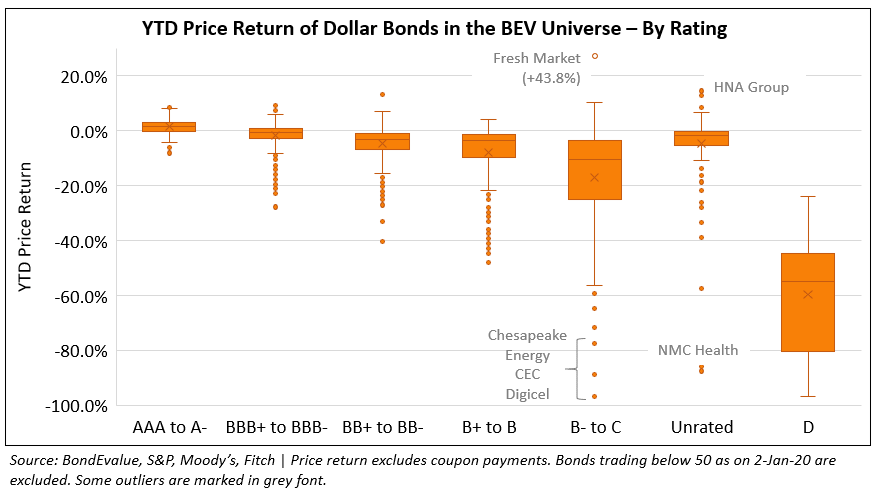This site uses cookies to provide you with a great user experience. By using BondbloX, you accept our use of cookies.
Bond Market News
Foxconn, Everbright, CapitaLand Launch Bonds; EU, Oman & ICD Hire Bankers for New Bond; Softbank’s Stock & Bonds Trade Up
October 20, 2020


US stock markets fell yesterday with the S&P down 1.6%. Tech heavyweights like Apple, Amazon and Microsoft were down over 2% each. Netflix is scheduled to report earnings after market close. US House Speaker Pelosi and Treasury Secy. Mnuchin are in constant talks to iron out differences by tonight to get clarity on a pre-election bill getting passed. US Treasuries widened slightly with the 10Y at 0.77% while US IG CDS spreads were wider 1.9bp and HY was flat. European peripheral spreads widened vs. core, with the BTP-Bund spread up 6bp to 134bp. European IG CDS spreads were higher 0.7bp while Crossover spreads were wider by 3bp. China’s GDP came at 4.9% for Q3, lower than expectations of 5.2% but showing a second straight quarter of positive growth post Covid. Asian equities are softer in trade today following US stocks, down ~0.4% with Asia ex-Japan CDS spreads tighter by 1.4bp. Its another busy day at the Asian primary markets with 8 new deals announced.
New Bond Issues
- Foxconn $ 5/10yr @ T+175/205bp area
- China Everbright Limited $ Perp NC3 @ 4.35% area
- CapitaLand Retail China S$ Perp NC5 @ 3.625% area
- India Green Energy $ 3.5NC3 green @ 5.875% area
- Seazen Group $ 100 mn 364-day final @ 5.45%
- Peak Reinsurance $ Perp NC5 @ 5.75% area
- Chengdu Xiangcheng Investment EUR 3yr @ 4% area
- Hubei Science Tech Investment $ 300 mn 5yr @ 3.35% area

China Development Bank raised a total of ~$2.97bn via three-tranche bond offering in both dollars and euros. It raised:
- $1bn via 5Y bonds to yield 1.088%, 75bp over Treasuries and 35bp inside initial guidance of T+110 area
- $500mn via 10Y bonds to yield 1.721%, 95bp over Treasuries and 35bp inside initial guidance of T+130bp area
- €1.25bn ($1.47bn) 3Y bonds to yield 0.022%, 55bp over Mid-swaps and 25bp inside initial guidance of MS+80bp area.
The bonds are expected to be rated A+. The two dollar-tranches drew combined final orders over $6.7bn, 4.47x issue size; and orders for the euro tranche were said to be over €5.2bn ($6bn) before allocations were announced, 4.16x issue size.
Korea Development Bank raised $1bn from a dual-tranche bond offering. It raised $500mn via 3Y Covid-19 response social bonds to yield 0.5%, 40bp over Treasuries and 30bp inside initial guidance of T+70bp area. It also raised $500mn via 5.5Y bonds to yield 0.8%, 52.5bp over Treasuries and 27.5bp inside initial guidance of T+80bp area. The bonds have expected ratings of Aa2/AA/AA–. Proceeds from the 3Y Covid-19 response social tranche will include financing and/or refinancing loans and lines of credit that provide support for small and medium-sized enterprises as well as small offices affected by the coronavirus pandemic.
Singapore property trust Suntec REIT raised S$200m ($147.3mn) via a Perpetual non-call 5Y (PerpNC5) bond at 3.8%, 20bp inside initial guidance of 4% area. The bonds received final orders exceeding S$300mn ($220.95mn), 1.5x issue size. HSBC Institutional Trust Services (Singapore), in its capacity as trustee of Suntec REIT, will issue the unrated bonds. The bond has a call date in Oct 2025 and if not called, the coupon will reset on the same date to the initial spread of 329.5bp plus the prevailing 5Y Singapore dollar SOR with no step-up.
New Bonds Pipeline
- EU SURE EUR Bond
- Oman $ Bond
- Investment Corporation of Dubai $ Bond
- Guangxi Communications Investment Group $ Bond
- Meituan $ Bond
- Straits Trading SGD Bond
- Wenns Foodstuff debut $ Bond
Rating Changes
Moody’s reviews Concho Resources’ ratings for upgrade upon acquisition by ConocoPhillips
Fitch Downgrades AVIVA France to IFS ‘A+’; Outlook Negative
EU Hires Bankers for SURE Bonds; Oman and ICD Hires For Dollar Bonds
The European Union (EU) hired syndicate of banks as part of its issuance of SURE bonds. SURE is an acronym for “Support to mitigate Unemployment Risks in an Emergency”. Lead managers said that they would sell 10Y and 20Y social bonds in its first offering, which is part of an overall €100bn ($118bn) plan. BNP Paribas, Barclays, Deutsche Bank, Nomura and UniCredit will manage the sale a memo said.
Oman is planning to tap the dollar bond market with an expected three-trancher with 3Y, 7Y and 12Y maturities, as per a bond prospectus filed on October 19 seen by Reuters. The prospectus also states that Oman has begun talks with Gulf countries for financial support. The deal is expected to be of benchmark size, which implies a possible $500mn issue per tranche according to the Economic Times. This follows Oman’s downgrade by S&P to B+ last Friday. Bankers include Bank Muscat, First Abu Dhabi Bank, HSBC, Citi, Societe Generale, Natixis and Standard Chartered. Oman’s outstanding 4.125% 2023s and 5.375% 2027s traded at 99.4 and 95.3, down 0.27 and 0.56 respectively.
The Investment Corporation of Dubai (ICD), the investment arm of the Dubai government is planning to issue a 5Y dollar bond as part of a $2.5bn issuance program, according to Reuters. This follows a $2bn issuance by the Dubai government last month. Bankers include Citi, NBD Emirates, HSBC, JPMC, First Abu Dhabi Bank and Standard Chartered. ICD’s older 4.625% bonds due 2024 are marginally higher at 106.85, yielding 2.6% on the secondary markets.
Softbank’s Dollar Bonds Trend Higher While Its Stock Trades at a 20Y High
Japanese conglomerate Softbank saw its dollar bonds inch up over the last month with its 6% and 6.875% perpetuals returning 2.7% and 4% respectively since the start of the month. The rally has been more pronounced in its stock, which hit a 20-year high of ~JPY 7,200 ($68), returning 11% since the start of the month. In the table below, we have listed prices of some of its dollar bonds and its stock at various points through the past year to see how they have been trending.

All the bonds and stock are trading at higher levels compared to last year. As per Japan Times, the rally comes on the back of its asset selling spree that includes the sale of $13.7bn worth of Alibaba stock and Arm Ltd. to Nvidia for $40bn. Founder Masayoshi Son said in a conference call in August, “Defense is something that’s always necessary to fight and always a very important element of the fighting. Cash is actually the defense for us.”
The company, rated BB+/Ba3, is rumored to have taken $20bn worth of exposure to US stocks, according to people familiar with the matter reported by Bloomberg. This comes just over a month after it was given the “Nasdaq Whale” title after revelations of Softbank taking a $30bn exposure to US stocks via call options emerged. The Son-led company seems to be at it again. A person familiar with the matter told Bloomberg, “The strategy is currently built around expectations of a volatile third-quarter earnings season. SoftBank has been buying out-of-the-money call options, which deliver returns when share prices rise, and selling calls at even higher prices”. This trading strategy is called call spreads (Term of the day, explained below)
For the full story, click here
Founder Group Bondholders Initiate Legal Action On Keepwell Provisions
Investors of dollar bonds from troubled Peking University Founder Group (PUFG) initiated legal action to seek more protection on ‘keepwell provisions’ according to a Bloomberg report. Sources say that BNY Mellon, the trustee of the bonds filed a winding-up petition against Nuoxi Capital, a PUFG company that issued the $300mn 4.575% dollar bonds, to the Eastern Caribbean Supreme Court in the British Virgin Islands last Friday. BNY Mellon is also said to file a petition against Hongkong JHC, the guarantor of the bonds. The ultimate parent company PUFG provided a keepwell deed to bondholders in their bond prospectus that highlighted two aspects:
- PUFG shall hold at least 85% of the shares of the Guarantor and not encumber, dispose or pledge the shares; that the Guarantor would own all outstanding shares of the Issuer without encumbrance, disposal or pledging
- As to what constitutes a default, not only is non-payment of interest or principal a default, but even non-compliance with the keepwell deed without a remedy within 30 days could also be considered default
In August, the restructuring administrators of PUFG, which includes the PBOC and the Ministry of Education rejected recognition of investors’ claims on a $300mn dollar bond that had the keepwell clause. This case is being closely tracked among bond investors as it potentially impacts all bonds that carry a keepwell agreement clause, which has been common in offshore bonds by Chinese issuers.
PUFG has been struggling with a big debt pile of $1.9bn and liquidity issues (cash of $230mn and receivables of $338mn) as of 2019-end based on Reuters data. Nuoxi’s dollar bonds trade at distressed levels with the 7.875% 2021s at 26 and the 7.45% 2022s at 25 cents on the dollar.
Cathay Pacific Sees Capacity Utilization at a Dismal 50% of Pre-Covid Times in 2021
Hong Kong’s Cathay Pacific Airways expects capacity utilization to be just 50% of pre-pandemic levels in 2021. In its strategic review, the airlines said that it planned to operate ~10% of its capacity in 2020 due to strict border enforcements in place. The capacity was expected to remain below 25% of pre-Covid levels in the first half of 2021 and then pick up in the second half to 50% subject to the development of vaccines. The airline industry has been hit hard by the pandemic and Cathay’s passenger numbers for September were down a whooping 98.1% compared to last year while its cargo carriage was down by 36.6%. The airline has put 40% of its passenger fleet under storage and is expected to resort to a restructure plan, according to the SCMP. The restructuring could include reducing staff, following in line with other major airlines such as Singapore Airlines and Qantas that have plans to cut 20% and 30% positions respectively. The Hong Kong government had led a massive HKD 39bn ($5bn) bailout package for the flag carrier in June that had received the shareholders’ approval in July. The airlines’ 3.375% SGD bonds due 2023 were trading marginally up by 0.03 to ~93.3 cents on the dollar.
For the full story, click here
ConocoPhillips To Buy Concho Resources for $9.7bn
ConocoPhillips announced a $9.7bn acquisition of Concho Resources with the transaction expected to close in 1Q2021. Both oil and gas exploration and production companies agreed for an all stock agreement of 1 share of Concho exchanged for 1.46 shares of ConocoPhillips. This would likely create a combined enterprise value of $60bn and make the company among the top producers in the Permian Basin. The combined balance sheet is expected to have net debt of $12bn and a leverage ratio of 1.3x. The acquisition would also improve scale (over 1.5mn barrels of oil equivalent per day) and lead to capturing annual cost and capital savings of $500mn by 2022. ConocoPhillips is rated ‘A’ by S&P. Its 1.18% bonds due 2022 were unchanged at 100.84, yielding 0.65%.
For the full story, click here
Term of the Day
Call Spreads
This is an options trading strategy that is placed to take advantage of an increase in price of the underlying. It involves buying a call option on a security and simultaneously selling a call option on the same security but with a higher strike price. The strategy pays off when the underlying security’s price increases by an amount that is greater than the net premium paid to purchase the call options. The maximum payoff though is capped at the level of the higher strike price. This can be better understood with an example.
S&P (the underlying) is currently at 3,427. One could buy a call spread by buying a call option with a strike price of 3,450 and selling a call option with a strike price of 3500. The premium paid is the difference between the option prices of the 3,450 and 3,500 calls. Therefore at expiration, if S&P trades at 3,475, one would make a payoff of 25 (3,475-3,450). But if S&P trades beyond 3500, the payoff would be capped at 50 (3,500-3,450) since the 3500 strike call would make losses, offsetting the gains from the 3,450 calls (see chart below). Whilst very common in the equities space, options are also present in the interest rates space with options on Eurodollar futures and Treasury futures.

Talking Heads
“In different times in world history, different countries have been the ones who have had the most amount of cash. And now it happens to be China, so China will naturally invest all over the world,” Mr. Cabraal. “I think we should all respect that,” said the Minister.
“Nobody says China has given $1.5 trillion loans to the U.S.? We are talking about $700 million coming in… these are the trade practices, financing practices, prevalent in the world. Each country works out their own financing arrangements in line with what they feel is best for them,” Mr. Cabraal said, adding, other countries such as Japan, the U.S. and India have also been big investors in Sri Lanka. The U.S., for instance, “is a very strong investor in Sri Lanka’s sovereign bonds. I met the Indian CEO forum here, and I was quite surprised that there are more than 50 in Indian CEOs here.”
On investors giving up on Argentina bonds six weeks after $65 billion restructuring
Robert Koenigsberger, the chief investment officer at Gramercy Funds Management
“Argentina could have had a very virtuous start, and with that they would have captured much more positive investor sentiment,” said Koenigsberger. “The restructuring provided the possibility for something different. What we’re witnessing thus far is no vision, no plan, and no IMF program to anchor policy expectations.”
Jorge Piedrahita, managing partner at Gear Capital Partners in New York
“To restore confidence you need an implementation of macro programs that are consistent and technically well-thought out, with buy-in from politicians,” said Piedrahita. “I don’t see the government working in that direction. They’re just slapping on small band-aids here and there.”
“We think it’s a 50-50 call as both an unchanged outlook as well as a downgrade could be justified,” wrote Sokos, citing S&P’s outlook criteria from April. The scale of the market reaction to a potential downgrade will depend on whether investors lighten their positions ahead of the decision this week, and on the ECB’s “willingness to actively fade a potential widening move, ” Sokos said.
On Zambia closer to being Africa’s first sovereign default since coronavirus pandemic started
Anthony Simond, a portfolio manager at Aberdeen Standard Investments
“In all likelihood the vote will fail,” said Simond. “The feeling is that the Zambians haven’t given bondholders sufficient evidence that it has a coherent fiscal plan that brings debt sustainability back on track.”
Richard Briggs, an investment manager at GAM Ltd.
“The Zambian authorities should engage with the bondholders and be clear about what it is they are trying to achieve,” said Briggs. “The coupon delay in isolation, without a plan, doesn’t do that, particularly given a lack of detail around the progress on an IMF program and visibility on Chinese lending.”
On foreign inflows into Asian bonds more than doubling in September
“The strong inflows into Thai debt in September could be due to some extent to portfolio rebalancing from equities to debt securities,” said Duncan Tan, a strategist at DBS Bank, adding that Thai equities had seen “heavy outflows” in recent months.
Khoon Goh, head of Asia Research at ANZ,
Goh said inflows to the region in general should resume once uncertainty around the highly-contested U.S. election in November is “out of the way” given the economic backdrop. “Asia’s economic recovery is well underway. Monthly PMIs have gained further traction and exports are recovering well,” he added.
Top Gainers & Losers – 20-Oct-20*
Go back to Latest bond Market News
Related Posts:










